Search the Special Collections and Archives Portal
Search Results
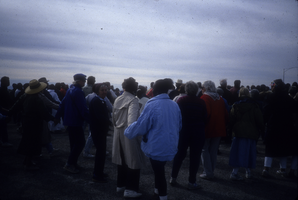
Slide of protesters holding hands at a demonstration near the Nevada Test Site, March 10, 1991
Date
1991-03-10
Archival Collection
Description
Color image of protesters holding hands at a Park-n-Ride lot preparing for an anti-nuclear testing demonstration organized by Lenten Desert Experience (also called Nevada Desert Experience) in the Nevada desert.
Image
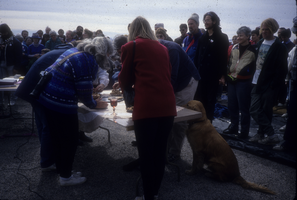
Slide of protesters at a makeshift altar at a demonstration near the Nevada Test Site, March 10, 1991
Date
1991-03-10
Archival Collection
Description
Color image of protesters next to a makeshift altar at a Park-n-Ride lot, preparing for an anti-nuclear testing demonstration organized by Lenten Desert Experience (also called Nevada Desert Experience) in the Nevada desert.
Image
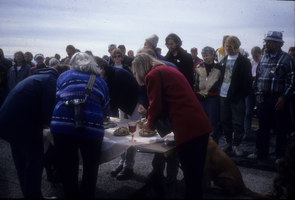
Slide of protesters at a makeshift altar at a demonstration near the Nevada Test Site, March 10, 1991
Date
1991-03-10
Archival Collection
Description
Color image of protesters next to a makeshift altar at a Park-n-Ride lot, preparing for an anti-nuclear testing demonstration organized by Lenten Desert Experience (also called Nevada Desert Experience) in the Nevada desert.
Image
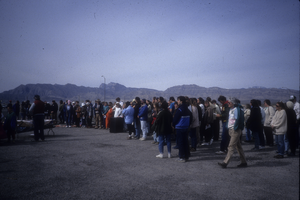
Slide of protesters at a demonstration near the Nevada Test Site, March 10, 1991
Date
1991-03-10
Archival Collection
Description
Color image of protesters at a Park-n-Ride lot preparing for an anti-nuclear testing demonstration organized by Lenten Desert Experience (also called Nevada Desert Experience) in the Nevada desert.
Image

Photograph of Minnesota football fans in the Copa Room at the Sands Hotel, Las Vegas, circa September 20, 1965
Date
1965-09-20
Archival Collection
Description
A group of Minnesota Football fans in the Copa Room at the Sands Hotel and Casino located in Las Vegas, Nevada. The group was returning from the Minnesota vs. UCLA game (the game was on September 17, 1965 and ended with a tied score of 20-20). Site Name: Sands Hotel and Casino
Image
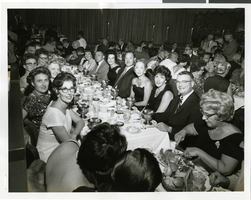
Photograph of the Empire Crafts executives in the Copa Room at the Sands Hotel, Las Vegas, circa September 1962
Date
1962-09
Archival Collection
Description
An unidentified group of executives from Empire Crafts at a dinner and show in the Copa Room at the Sands Hotel in Las Vegas, Nevada.
Image
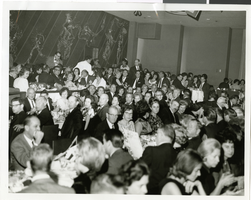
Photograph of the Menorah Lodge of Los Angeles in the Copa Room at the Sands Hotel, Las Vegas, December 1965
Date
1965-12
Archival Collection
Description
A group of individuals from the Menorah Lodge of Los Angeles in the Copa Room at the Sands Hotel in Las Vegas, Nevada. The group was in Las Vegas to play the Paradise Valley Golf Tournament.
Image
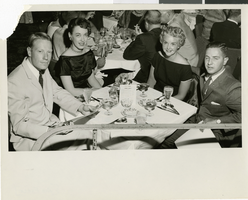
Photograph of Darlene Dahlberg, Sands Hotel, Las Vegas, circa 1958-1959
Date
1958 to 1959
Archival Collection
Description
Darlene Dahlberg, a beauty pageant winner from Denver, Colorado, at the Sands Hotel in Las Vegas, Nevada. From left to right, 1st Lieutenant Don Horst, Nancy Puett (Chaperone), Darlene Dahlberg (John Robert Powers beauty pageant winner), and 1st Lieutenant Arnold Widder at the Sands Hotel with other beauty pageant winners.
Image

Photographs of Jack Entratter with his wife Dorothy Entratter at the airport in Las Vegas, circa 1958-1961
Date
1958 to 1961
Archival Collection
Description
Jack Entratter with his wife Dorothy Entratter and his daughters outside of a Pan American jet at the Las Vegas, Nevada airport.
Image
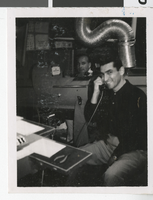
Photograph of Esper Esau and Pete Dante in light booth at Stardust Hotel, Las Vegas, April 1964
Date
1964-04
Archival Collection
Description
Black and white image of Esper Esau in light booth with Pete dante behind him at Stardust Hotel.
Image
Pagination
Refine my results
Content Type
Creator or Contributor
Subject
Archival Collection
Digital Project
Resource Type
Year
Material Type
Place
Language
Records Classification
